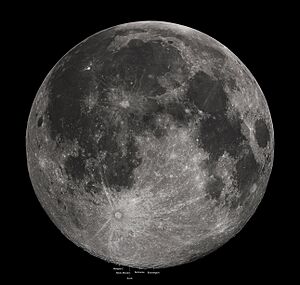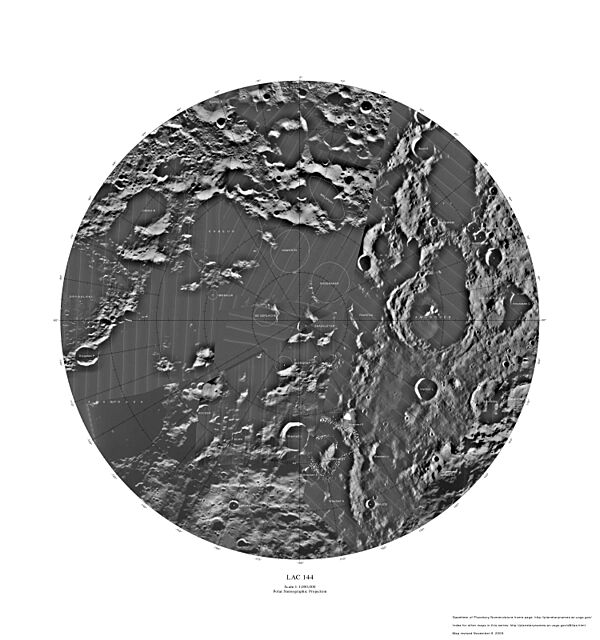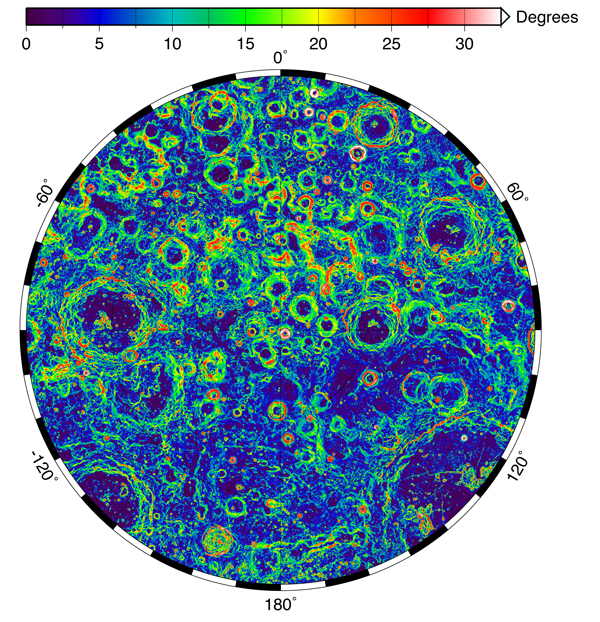Lunar south pole facts for kids
The lunar south pole is the very bottom of the Moon. Scientists are really interested in it because there's water ice hidden in places that are always in shadow. These shadowy spots are inside craters where sunlight never reaches. They are like "cold traps" that hold clues about the early Solar System, like hydrogen and water ice. The Moon's north pole doesn't have as many of these special shadowed craters.
Where is the Lunar South Pole?
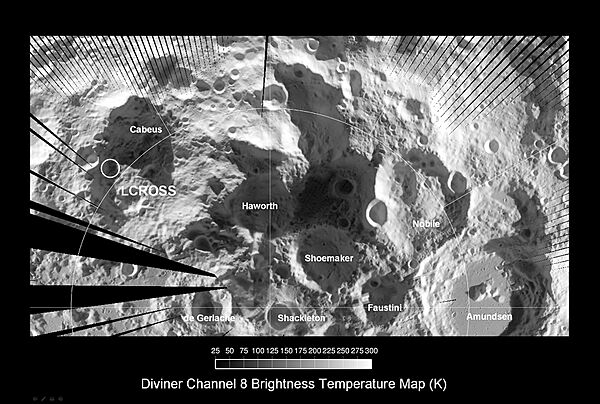
The lunar south pole is located in the Moon's polar region, between 80°S and 90°S. The Moon's spin axis is tilted, which means some areas near the pole get constant sunlight, while others are always in shadow. Over billions of years, the south pole has moved a little. This shift changed how sunlight hits the Moon's surface.
The south pole region has many large craters and basins. One of the biggest is the South Pole–Aitken basin. There are also tall mountains, like Epsilon Peak, which is taller than any mountain on Earth. The average temperature at the south pole is about -13 °C (9.5 °F).
Craters Near the South Pole
The exact spot of the Moon's spin axis is inside Shackleton Crater. Other important craters close to the lunar south pole include de Gerlache, Sverdrup, Shoemaker, Faustini, Haworth, Nobile, and Cabeus.
What Have We Discovered?
Sunlight and Shadows
The lunar south pole has crater rims that are almost always lit by the Sun. But the inside of these craters are always dark. Scientists have studied how sunlight hits this area using detailed maps from the Lunar Reconnaissance Orbiter. The Moon's surface can also reflect solar wind particles. About 16% of these particles are protons, and their amount changes depending on the location. These reflected particles help scientists understand the Moon's surface and its magnetic fields.
Cold Traps and Water Ice
Cold traps are very important areas at the lunar south pole. They might hold water ice and other frozen materials. This ice could have come from comets, meteorites, or even the solar wind. Experiments and samples have shown that cold traps do contain ice. Scientists have also found Hydroxyl in these areas. Finding water and hydroxyl has led to new missions that use special cameras to look for these compounds from orbit. The ice stays frozen in these traps because of the Moon's temperature, which is affected by sunlight, heat from the Moon itself, and light from Earth.
Magnetic Areas
Some parts of the Moon's crust have magnetic fields. This is unusual because the Moon doesn't have a global magnetic field like Earth. These "magnetic anomalies" might be left over from when a large object crashed into the Moon, forming the South Pole–Aitken basin. This impact might have left behind magnetic iron. However, maps haven't found enough iron to explain these magnetic areas. This means the magnetic fields might be caused by something else, or the iron is too deep to be seen.
Exploring the South Pole
Space Missions
Many countries have sent orbiters to explore the lunar south pole. Missions like the Lunar Orbiters, Clementine, Lunar Prospector, Lunar Reconnaissance Orbiter, Kaguya, and Chandrayaan-1 have all found signs of lunar water. NASA's LCROSS mission even crashed into Cabeus crater and found that the soil there contained almost 5% water.
Lunar Reconnaissance Orbiter (LRO)
The Lunar Reconnaissance Orbiter (LRO) was launched by NASA on June 18, 2009. It is still mapping the lunar south pole region. This mission helps scientists figure out if there are enough resources at the south pole to support a permanent human base. LRO carries a special tool called the Diviner Lunar Radiometer Experiment. This tool studies the heat and surface properties of the south pole. It can detect reflected sunlight and heat coming from the Moon, helping to find where water ice might be trapped.
LCROSS Mission
The Lunar Crater Observation and Sensing Satellite (LCROSS) was a robotic spacecraft from NASA. Its main goal was to find out more about the hydrogen found at the Moon's poles. LCROSS was launched right after Chandrayaan-1 found water on the Moon. LCROSS's main job was to confirm if there was water ice in a permanently shadowed crater near one of the Moon's poles. It launched with the Lunar Reconnaissance Orbiter (LRO). LCROSS successfully confirmed water in the southern lunar crater Cabeus.
Moon Impact Probe (MIP)
The Moon Impact Probe (MIP) was made by the Indian Space Research Organisation (ISRO). It was released from ISRO's Chandrayaan-1 orbiter, which launched on October 22, 2008. The Moon Impact Probe separated from Chandrayaan-1 on November 14, 2008. After about 25 minutes, it crashed as planned near the edge of Shackleton Crater. With this mission, India became the first country to land or impact near the lunar South Pole.
Luna 25
Russia launched its Luna 25 lunar lander on August 10, 2023. Luna 25 traveled to the Moon for five days, then orbited it for another five to seven days. It was supposed to land in the Moon's south polar region, near the crater Boguslawsky. However, Luna 25 had an "emergency situation" while getting ready to land and lost communication on August 19, 2023. Luna 25 was designed to test landing technology and carried scientific tools to collect soil samples.
Chandrayaan-3
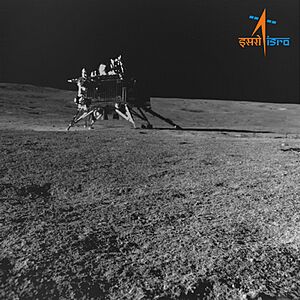
On August 23, 2023, India's Chandrayaan-3 became the first lunar mission to successfully make a soft landing near the lunar south pole. The mission included a lander and a rover to perform scientific experiments.
IM-1 Odysseus
The IM-1 Odysseus lander took about six days to travel from Earth to the Moon. It then orbited the Moon for about one more day. It landed on February 22, 2024. The original goal was to land within the Malapert-A crater, which is about 300 kilometers (186 miles) from the lunar south pole. Odysseus became the first US Moon landing in the 21st century.
EagleCam to Record Landing
Just before landing, the Odysseus lander was supposed to release a camera called EagleCam. This camera would have dropped near the lander to record the landing. However, due to a software problem, EagleCam was not released during the landing. It was released later on February 28, 2024, but it did not send back the main landing images that were its goal.
IM-2 Mission
Intuitive Machines's lunar lander IM-2 launched on February 27, 2025. It carried experiments and rovers for NASA to Mons Mouton. IM-2 landed on March 6, 2025. The spacecraft was intact but landed on its side, making its science mission harder. This was similar to what happened with the IM-1 Odysseus spacecraft in 2024. On March 13, 2025, Intuitive Machines shared that the lander's altimeter (which measures height) failed during landing. This meant the computer didn't know its exact height. As a result, the spacecraft hit a plateau, tipped over, and slid across the Moon's surface, rolling once or twice before stopping inside a crater. The impact also kicked up dust, which covered the solar panels and reduced their power.
Future Exploration and Observations
The lunar south pole region is a very interesting place for future missions and a good spot for a lunar outpost. The permanently shadowed areas might hold ice and other minerals. These would be very important resources for future explorers. The mountain peaks near the pole get sunlight for long periods, which could provide solar energy for an outpost. With a base on the Moon, scientists could study water and other samples that date back to the formation of the Solar System.
Scientists used a tool called LOLA (Lunar Orbiter Laser Altimeter) to create an accurate map of the Moon. This data showed that some spots near the south pole, like Connecting Ridge, get sunlight for 92% to 95% of the time. At these same spots, the longest periods of darkness were only 3 to 5 days.
The lunar south pole is also a great place for unique astronomical observations. Scientists could study radio waves below 30 MHz. China's Longjiang microsatellites orbited the Moon in 2018, and Longjiang-2 operated in this frequency until July 31, 2019. Before Longjiang-2, no space observatory could study these radio waves because of interference from Earth. The lunar south pole has mountains and basins, like the south side of Malapert Mountain, that face away from Earth. This makes them ideal spots for a ground radio observatory to receive these signals.
Resources on the Moon
| Compound | Formula | Composition | |
|---|---|---|---|
| Maria | Highlands | ||
| Silica | SiO2 | 45.4% | 45.5% |
| Alumina | Al2O3 | 14.9% | 24.0% |
| Lime | CaO | 11.8% | 15.9% |
| Iron oxide | FeO | 14.1% | 5.9% |
| Magnesia | MgO | 9.2% | 7.5% |
| Titanium dioxide | TiO2 | 3.9% | 0.6% |
| Sodium oxide | Na2O | 0.6% | 0.6% |
| Total | 99.9% | 100.0% | |
The south polar region has plenty of solar power, oxygen, and metals. If a facility to process lunar resources were built near the south pole, it could use solar power to operate almost all the time. Elements found on the Moon's surface include hydrogen (H), oxygen (O), silicon (Si), iron (Fe), magnesium (Mg), calcium (Ca), aluminium (Al), manganese (Mn), and titanium (Ti). Oxygen, iron, and silicon are among the most common. Oxygen makes up about 45% of the Moon's surface by weight.
What's Next?
Blue Origin is planning a mission to the south polar region. Their Blue Moon lander uses technology similar to their New Shepard rocket. This mission could lead to a series of landings to set up equipment for a human base in a south polar crater.
NASA's Artemis program plans to send several robotic landers and rovers (CLPS) to the south pole. These missions will prepare for the planned Artemis III human landing in the late 2020s.
See also
 In Spanish: Polo sur de la Luna para niños
In Spanish: Polo sur de la Luna para niños
- Face on Moon South Pole
- Geology of the Moon
- Lunar north pole
- Lunar resources
- Selenography



